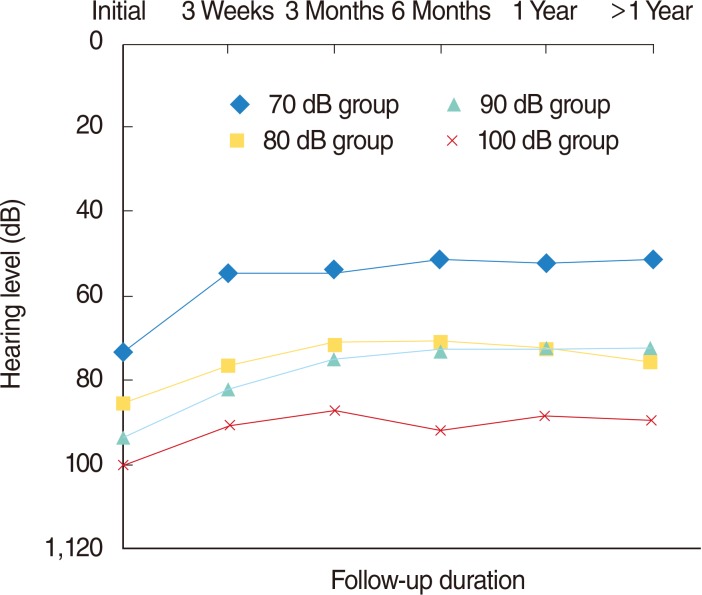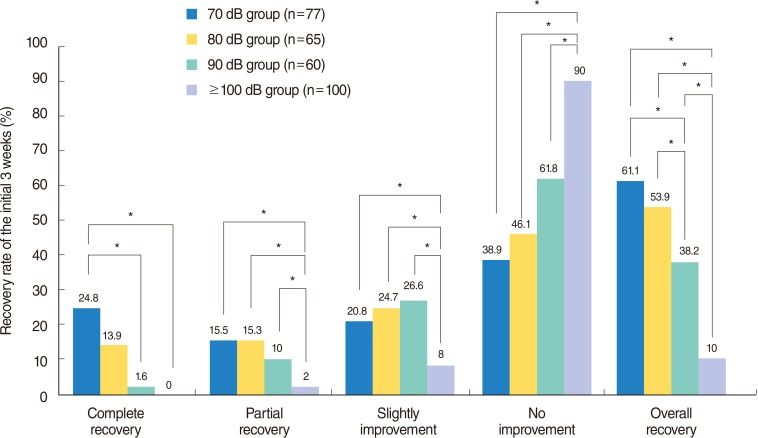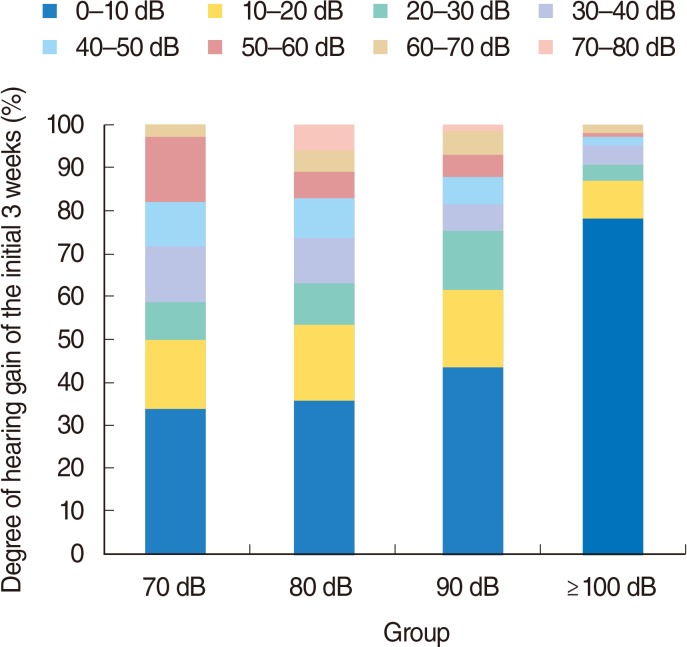This article has been
cited by other articles in ScienceCentral.
Abstract
Objectives
While a severe to profound sudden sensorineural hearing loss (SSNHL) may cause serious disability in verbal communication, there have been little studies focusing on this high degree SSNHL. The present study was aimed to investigate the characteristics of hearing recovery in a high degree SSNHL (>70 dB).
Methods
Three hundred and two SSNHL patients were enrolled. For a long-term follow-up, 46 patients were evaluated. Hearing level was examined by pure tone audiometry on day 1, week 3, month 3, month 6, and year 1 or after. According to the degree of the initial hearing loss, the patients were divided into 4 groups from 70 to ≥100 dB.
Results
After 3 weeks, the recovery rate and mean hearing gain was 61%, 23.85 dB in the 70 dB group, whereas 10%, 6.61 dB in the ≥100 dB group. There was a significant correlation between 3-week recovery and final hearing outcome. However, there was almost no recovery after 3 months.
Conclusion
An early recovery can be a prognostic factor for the final recovery in severe to profound SSNHL. Since recovery after 3 months is rare, an early hearing intervention like hearing aid or cochlear implantation should be considered in the high degree SSNHL to restore the patient's verbal communication.
Go to :

Keywords: Hearing Loss, Sudden, Treatment Outcome, Ear, Inner, Cochlea
INTRODUCTION
Idiopathic sudden sensorineural hearing loss (SSNHL) has been long known since its first documentation in 1944 [
1]. It is not rare with a prevalence of 5 to 20 per 100,000 people in the United States [
2]. However, its pathophysiology and causes have not been fully determined. The recovery rates varied according to the investigators. Among the prognostic factors is the severity of initial hearing loss [
234567]. If the severity of initial hearing loss is high, the recovery rate is low. Seventy-decibel (dB) hearing is considered as a significantly difficult level for verbal communication, and a patient usually needs hearing aid. Even with the hearing device, he/she may encounter unsatisfactory understanding. If one cannot recover the 70-dB threshold, he/she may be separated from the verbal society. Therefore, a 70-dB loss has been regarded as a level considering cochlear implantation in many studies. There have been little studies focusing on severe to profound SSNHL. The present study was aimed at investigating the recovery pattern from a high degree SSNHL (≥70 dB). It was also aimed to determine a proper time to consider using hearing interventions such as hearing aid or cochlear implantation.
Go to :

MATERIALS AND METHODS
Patients
We conducted a retrospective study of patients who were admitted for the treatment of SSNHL between January 2002 and May 2012 at the Department of Otolaryngology, Chonnam National University Hospital. We excluded patients with the following conditions: (1) previous SSNHL history, (2) hearing impairment on the contralateral ear, (3) underlying disease such as diabetes mellitus, hypertension, (4) the presence of vertigo, (5) more than one month duration between onset and treatment, (6) anatomical abnormalities detectable by brain imaging (computed tomography, magnetic resonance imaging) as congenital anomaly in the cochlea or acoustic neuroma etc. Consequently, 302 patients were included in this study. The patients were comprised of 143 males and 159 females, with an average age of 47.9 years. For the long-term follow-up study, a total of 46 patients were recruited. The age, sex, onset time of treatment and follow-up period were evaluated. The participants' demographics are summarized in
Table 1.
Table 1.
Demographics of 46 patients in the long-term study and of total 302 patients
|
Demographic |
Group
|
Total |
P-value |
|
70 dB |
80 dB |
90 dB |
Scale out |
|
Age (year), mean (range) |
|
|
|
|
|
|
|
Total |
48.4 (7–77) |
49.5 (6–81) |
46.9 (5–77) |
46.9 (6–79) |
47.9 (5–81) |
NS |
|
Long-term follow-up |
48.9 (16–64) |
47.7 (9–81) |
38.8 (6–64) |
47.4 (12–75) |
44.8 (6–81) |
NS |
|
Sex (male:female) |
|
|
|
|
|
|
|
Total |
34:43 |
38:27 |
29:31 |
42:58 |
143:159 |
NS |
|
Long-term follow-up |
3:7 |
6:5 |
5:11 |
3:6 |
17:29 |
NS |
|
Mean follow-up duration (week) |
42.31 |
42.74 |
18.12 |
25.23 |
29.27 |
NS |
|
Treatment onset (day), mean (range) |
3.12 (7–77) |
6.85 (6–81) |
4.67 (5–77) |
5.03 (6–79) |
5.56 (5–81) |
NS |

Treatment protocol
All patients were treated within 12 days by systemic administration of steroid hormones in combination with Pentaspan for 7 days, 10% Magnesium sulfate for 7 days, and 5-mg/mL Eglandin (prostaglandin E1) for 5 days as reported previously [
8]. During the same period, they were given carbogen (95%O
2+5%CO
2) for 20 minutes twice a day. Intramuscular injection of methylprednisolone was used for systemic steroids for 12 days including the tapering period. On days 1 to 4, 80 mg of prednisolone was administered, followed by 60 mg on days 5 and 6, 40 mg on days 7 and 8, 30 mg on day 9, 20 mg on day 10, and 10 mg on days 11 and 12. Patients who did not show any hearing improvement after 12 day's systemic steroid treatment, intratympanic dexamethasone injection was done every 2 days for 2 weeks. Fequencies of intratympanic steroid injection were as follow: 70.1% in 70 dB group, 69.2% in 80 dB group, 66.7% in 90 dB group, and 76% in ≥100 dB group. There was no difference in the frequency of intratympanic injection among 4 groups.
Evaluation of hearing recovery
The arithmetic mean of hearing levels at 500 Hz, 1 kHz, 2 kHz, and 4 kHz were used to evaluate hearing recovery. Hearing recovery was evaluated by measuring the hearing level at the first day and 3 weeks, 3 months, 6 months, and 1 year. Hearing level after one year was considered as final hearing. According to the degree of initial hearing level, we divided the patients into 4 groups of 10-dB intervals: 70 dB group, 80 dB group, 90 dB group, and ≥100 dB group. Assessment of the degree of hearing improvement was done according to Siegel's criteria as follows: (1) complete recovery: final hearing better than 25 dB, (2) partial recovery: more than 15-dB gain and final hearing 25-45 dB, (3) slight improvement: more than 15-dB gain and final hearing poorer than 45 dB, (4) no improvement: less than 15-dB gain and final hearing poorer than 75 dB [
9].
Statistics
Statistical analyses were performed by IBM SPSS ver. 19.0 (IBM Co., Armonk, NY, USA) chi-square, analysis of variance with Bonferroni correction and Pearson correlation analysis. A P-value less than 0.05 was considered as statistically significant.
Go to :

RESULTS
Age, sex, onset time of treatment and follow-up period were comparable among 4 groups (
Table 1). We looked at recovery time by conducting long-term follow-up of 46 patients (
Fig. 1). Changes in average hearing level in all the 4 groups showed the highest recovery during the initial 3 weeks after treatment. Slight recovery was observed between 3 weeks and 3 months. There was almost no recovery after 3 months. We examined the association between hearing gain in each time period and final hearing results using Pearson correlation analysis (
Table 2). Compared to a later time period, initial 3 weeks' recovery showed the strongest strong correlation with the final recovery level. This means that most of the recovery is presented already at the initial 3 weeks. In other words, the initial 3 weeks' recovery predicts the final outcome.
 | Fig. 1Recovery time among four groups according to the changes in average hearing levels by pure tone audiographic measurement. Note that, the initial 3 weeks showed the highest recovery rate, 3 weeks to 3 months demonstrated slight recovery but no improvement was noted after 3 months. 70 dB group, n=10; 80 dB group, n=11; 90 dB group, n=16; ≥100 dB group, n=9.
|
Table 2.
Correlation between the recovery level in each time period with final recovery outcome (n=46)
|
Initial 3 weeks |
3 Weeks to 3 months |
3 Months to 6 months |
6 Months to 1 year |
|
Pearson correlation coefficient |
0.729 |
0.400 |
0.183 |
0.218 |
|
P-value |
<0.01 |
<0.01 |
0.223 |
0.145 |

Considering these results, we evaluated a more large number of SSNHL with high degree hearing loss at 3 weeks (
Fig. 2). The results show that if the initial hearing level is bad, it is unlikely to achieve complete recovery and likely to have a higher portion of no improvement. In particular, in the ≥100 dB group, no patient showed complete recovery, and the majority showed no improvement. There were significant differences in the rate of complete recovery among the 70 dB group and 90 dB group. Partial recoveries and slight improvements were however comparable among 70 dB, 80 dB, 90 dB groups. Evenstill ≥ 100 dB group showed significant less portion of partial recovery and slightly improvement compared to other groups. The overall recovery rate was 61.02% in the 70 dB group and 10% in the ≥100 dB group. The results showed that as the initial hearing level got worse, the recovery rate got lower. This is consistent with previous studies that reported initial hearing loss is a predictive factor for hearing recovery.
 | Fig. 2Comparison of initial 3-week hearing recovery rates among the 70 dB group, 80 dB group, 90 dB group, and ≥100 dB group. The degrees of recovery for comparison were complete, partial, slight recovery according to Siegel's criteria. Overall recovery is the sum of complete recovery, partial recovery, slight improvement. Analysis of variance with Bonferroni correction (*P<0.05).
|
The level of 3-week hearing gain by a 10-dB degree difference in each group was also studied (
Fig. 3). The mean hearing gain was 23.85 dB in the 70 dB group, 23.94 dB in the 80 dB group, 19.03 dB in the 90 dB group and 6.61 dB in the ≥100 dB group. The average hearing gain was 18.36 dB overall. The mean hearing gain of the other groups was higher than that of the ≥100 dB group with statistical significance.
 | Fig. 3Comparison of hearing gain during initial 3-week period among the 70 dB group, 80 dB group, 90 dB group, and ≥100 dB group. Note that in the 70 dB group, there cannot be a gain value exceeding 70 dB. The degree of hearing gain is lower in the highest grade hearing loss group.
|
Go to :

DISCUSSION
There are several factors affecting the prognosis of SSNHL. Currently known prognostic factors include initial degree of hearing loss, time from onset to treatment, age, accompaniment of vertigo and tinnitus, and type of hearing loss [
234567].
A no correlation between the degree of hearing loss and prognosis has been claimed [
9]. However, many investigators agree that the initial degree of hearing loss is an important determinant of prognosis. Wilson et al. [
10] suggested that a hearing loss of 40 dB or less could be recovered regardless of whether the treatment was performed or not. Sheehy [
11] also noted that an initial hearing loss of 45 dB or less yielded a satisfactory prognosis. On the contrary, the severer the initial hearing loss, the worse the prognosis [
12]. Liu et al. [
13] reported that hyperbaric oxygen effectively resulted in a good to fair recovery in 72% of patients with an initial hearing level of over 91 dB (technically meaning deafness). On the other hand, corticosteroids were without effects when the initial hearing loss was 90 dB or more [
10]. According to Hong et al. [
7], among 34 patients who had an initial hearing loss of over 100 dB, none experienced a complete recovery, with only two showing a partial recovery. In the present study, we examined four groups of patients with SSNHL with different degrees of initial hearing loss from 70 dB to ≥100 dB. The recovery rate was the highest in the 70 dB group (61%), and 53.9% in the 80 dB group, 38.3% in the 90 dB group, and 10% in the ≥100 dB group. These results support the previous notion that the recovery rate decreases as a function of the severity of initial hearing loss.
Ito et al. [
14] reported that the hearing recovery during the initial 1-2 weeks has a good correlation with the final outcome. The recovery was seen mostly within 3 weeks in our study. The recovery at 3 weeks was positively correlated with final hearing gain. It is assumed that the early recovery rate predict the final outcome in severe to profound SSNHL also. There was a slight recovery during the period between 3 weeks to 3 months. The recovery was rarely seen thereafter. Only one patient in the 70 dB group and one patient in the 90 dB group showed a partial recovery among the 46 patients. We suggest that since recoveries after 3 months are rare, hearing intervention should be considered after this time period. We have previously reported that SSNHL occurring in the only hearing ear also shows rare recovery after 3 months [
8]. Accordingly, early hearing intervention as cochlear implantation should be considered to restore patient's verbal communication.
In conclusion, the level of initial hearing loss and the recovery rate in the initial 3 weeks are prognostic factors in the high degree of SSNHL. A recovery is rare after 3 months. An early hearing intervention such as hearing aid should be considered especially with a loss over 100 dB. If severe to profound SSNHL occurs in the only hearing ear, cochlear implantation may be considered as early as 3 months to restore the patient's verbal communication.
Go to :

ACKNOWLEDGMENTS
The authors thank E. M. Park, H. J. Park and Y. H. Choi for expert technical assistance. We gratefully acknowledge supports from the institute for this study.
Go to :

Notes
Go to :

References
1. De Kleyn A. Sudden complete or partial loss of function of the octavus-system in apparently normal persons. Acta Otolaryngol. 1944; 1. 32(5-6):407–429.
2. Byl FM Jr. Sudden hearing loss: eight years' experience and suggested prognostic table. Laryngoscope. 1984; 5. 94(5 Pt 1):647–661. PMID:
6325838.
3. Cvorovic L, Deric D, Probst R, Hegemann S. Prognostic model for predicting hearing recovery in idiopathic sudden sensorineural hearing loss. Otol Neurotol. 2008; 6. 29(4):464–469. PMID:
18434930.
4. Jun HJ, Chang J, Im GJ, Kwon SY, Jung H, Choi J. Analysis of frequency loss as a prognostic factor in idiopathic sensorineural hearing loss. Acta Otolaryngol. 2012; 6. 132(6):590–596. PMID:
22497556.

5. Ceylan A, Celenk F, Kemaloglu YK, Bayazit YA, Goksu N, Ozbilen S. Impact of prognostic factors on recovery from sudden hearing loss. J Laryngol Otol. 2007; 11. 121(11):1035–1040. PMID:
17241495.

6. Narozny W, Kuczkowski J, Kot J, Stankiewicz C, Sicko Z, Mikaszewski B. Prognostic factors in sudden sensorineural hearing loss: our experience and a review of the literature. Ann Otol Rhinol Laryngol. 2006; 7. 115(7):553–558. PMID:
16900810.

7. Hong SM, Ko YG, Park CH, Lee JH, Kim JH. Analysis of hearing improvement in patients with severe to profound sudden sensorineural hearing loss according to the level of pure tone hearing threshold. Eur Arch Otorhinolaryngol. 2012; 9. 269(9):2057–2060. PMID:
22143582.

8. Lee SS, Cho HH, Jang CH, Cho YB. Fate of sudden deafness occurring in the only hearing ear: outcomes and timing to consider cochlear implantation. J Korean Med Sci. 2010; 2. 25(2):283–286. PMID:
20119584.

9. Siegel LG. The treatment of idiopathic sudden sensorineural hearing loss. Otolaryngol Clin North Am. 1975; 6. 8(2):467–473. PMID:
1153209.

10. Wilson WR, Byl FM, Laird N. The efficacy of steroids in the treatment of idiopathic sudden hearing loss: a double-blind clinical study. Arch Otolaryngol. 1980; 12. 106(12):772–776. PMID:
7002129.

11. Sheehy JL. Vasodilator therapy in sensory-neural hearing loss. Laryngoscope. 1960; 7. 70:885–914. PMID:
14445724.

12. Byl FM. Seventy-six cases of presumed sudden hearing loss occurring in 1973: prognosis and incidence. Laryngoscope. 1977; 5. 87(5 Pt 1):817–825. PMID:
850455.

13. Liu SC, Kang BH, Lee JC, Lin YS, Huang KL, Liu DW, et al. Comparison of therapeutic results in sudden sensorineural hearing loss with/without additional hyperbaric oxygen therapy: a retrospective review of 465 audiologically controlled cases. Clin Otolaryngol. 2011; 4. 36(2):121–128. PMID:
21414179.

14. Ito S, Fuse T, Yokota M, Watanabe T, Inamura K, Gon S, et al. Prognosis is predicted by early hearing improvement in patients with idiopathic sudden sensorineural hearing loss. Clin Otolaryngol Allied Sci. 2002; 12. 27(6):501–504. PMID:
12472519.

Go to :







 PDF
PDF Citation
Citation Print
Print



 XML Download
XML Download